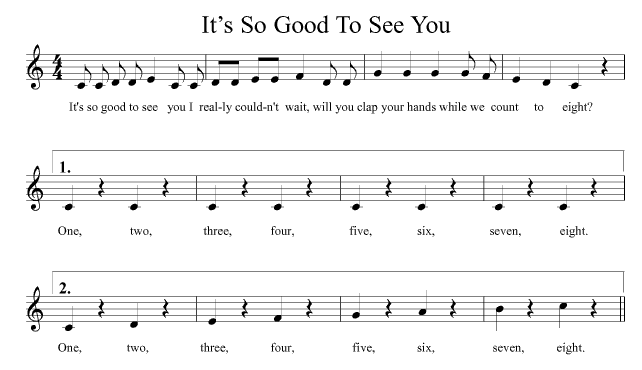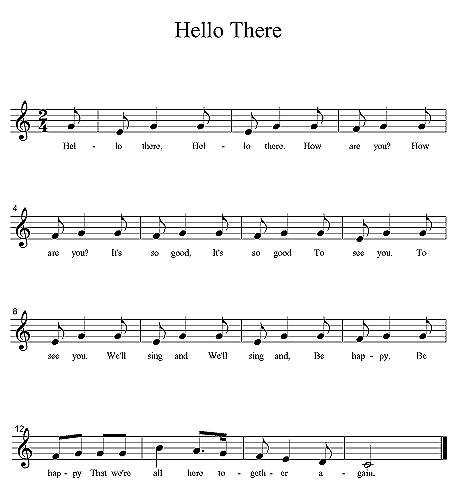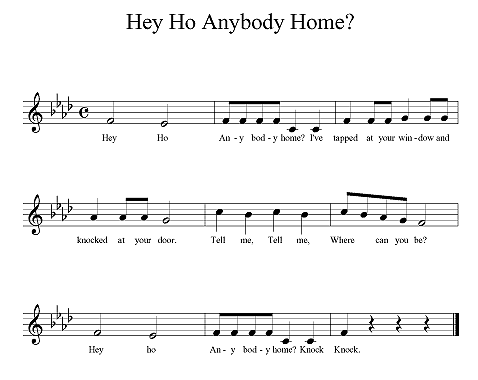The activities in this section are effective in helping children:
- count
- demonstrate that music is a part of daily life
- develop small motor activity
- explore symbolic representation
- explore the symbolic representation of picture, word, and notation
- experiment with a variety of instruments and other sound sources
- express themselves
- gain social awareness by greeting others
- have opportunities for free improvised singing and vocal play
- learn to pay attention as they echo phrases
- make music on an instrument
- sing, play instruments, move, or verbalize to demonstrate awarenessof the elements of music and changes in their usage
- use their voices expressively as they speak, chant, and sing
- gain rhythmic awareness with large motor activities (clapping)
"Twinkle, Twinkle Little Star"
| Children respond quickly to familiar songs. "Twinkle, Twinkle LittleStar" can be extended beyond its own simplicity to incorporate other areasof learning in the young child’s life. Use this song to develop small motoractivity, serve as a classroom management tool, and explore the symbolicrepresentation of pictures in word and notation. |
Procedures
- While singing the song, open and shut fingers to look like stars.The sound pattern of this tune is ABA with the first and last section soundingthe same and the middle section sounding different. Show the children howto open and shut their stars at chest level for the A sections and overheadfor the B section.
- Create a book. Pages one and three show a star and page two a diamondshape, page four shows the text, and page five the notation – so the songis then represented symbolically as pictures, words, and notation.
- "Twinkle, Twinkle Little Star" makes an especially good gatheringsong because it is familiar and well-loved. You can sing it as a cue thatchildren are to gather for circle time.
"It’s So Good to See You"
| This is a hello song that involves exploration of the singing and speakingvoice. This song is great for substituting various actions for a patternwithin the song and extending motions to a percussion instrument. Thesong also works well as a goodbye song. |
Procedures
- While singing the song, add motions for the numbers.
- Ask the children to join with you by clapping on the numbers only.
- Invite children to discover other places for the numbers (pat head, touchyour nose, nod your head, shake my hand, and so on).
- Explore saying the numbers in a variety of ways: whisper, high voices,low voices, slowly, quickly, in reverse order. Then try thinking the numbers!
Extensions
If the class is ready, ask the children for suggestions about an instrumentto play as they sing the numbers. Then transfer the "1-8" sequence to melodybells or other such instruments.
"Hello There"
| Welcoming and hello songs are a natural way to begin routines. In thissong each child has the opportunity to sing his or her name either aloneor with a group. |
Procedures
- Invite the children to sing after you.
- Keep a steady beat on your knees throughout the song.
- Use expressive arms to conduct the longer length of the last phrase:"That we’re all here together today."
- Transfer children’s names to the melody.
"Who’s That Tapping at the Window?"
| Life can be a song! This is a great song for guests who knock at yourdoor or who tap at your window. Children can explore transferring a musicalpattern to a musical instrument and following a symbolic representationof a song. |
Procedures
- Sing the entire song for the children.
- Pat knees on the phrase "tappingat the window" and pat floor at "knocking at the door."
- Ask children to sing, "[name] is tapping at the window; [name] isknocking at the door" substituting their own names. Make certain that theycan all tap or pat the rhythm for the words, "tapping at the window" and"knocking at my door."
- Guide children to transfer the patterns, "tapping at the window"and "knocking at the door" to an unpitched percussion instrument (suchas wood block, or drum).
- After the children have explored the song and discovered ways toplay the patterns, introduce the puzzle picture for individual play incenters.
Extensions
Sing the song, "Hey Ho, Anybody Home," which is a modal song – that is,it is not in a major key. Singing a song that is "different" in this wayprovides children opportunities to discriminate the organization of sound.

| Provided in partnership with NAfME |





